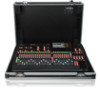Behringer X32-TP User Manual - Page 57
Utility Screen, Channel Preamp Screen
 |
View all Behringer X32-TP manuals
Add to My Manuals
Save this manual to your list of manuals |
Page 57 highlights
57 X32 DIGITAL MIXER Preliminary User Manual 7.9 Utility Screen The utility screen is a supplemental screen designed to work in conjunction with the other screens that may be in view at any particular moment. The utility screen is never seen by itself, it always exists in the context of another screen. To reinforce this point, when the utility screen button is pressed, it illuminates at the same time that another screen button is also illuminated, showing you which screen it is providing extra utilities for. For most screens, pressing the utility button simply acts as a shortcut to a page that can be navigated to by other means. In a few cases, a utility page provides extra utility functions not seen anywhere else. The utility button works in the following manner with the other screens on the console: Channel Preamp Screen: 1. Home Page: Takes the user directly to the channel tab of the library screen. 2. Config Page: Provides an interface for assigning a custom color, icon, and name to the input or output channel. • Adjust and tap the 6 encoders to assign a color, name, and icon to the currently selected input or output channel. Tap the 6th encoder to exit and save the changes. • By assigning custom names to each channel, which are then displayed in the channel LCD displays, the console achieves superior userfriendliness. For example, Input 1 can display "kick drum" and show a kick drum icon, while output channel 5 can display "Tom's monitor mix" and show an icon of stage monitor. 3. All other pages: Takes the user directly to the channel tab of the library screen. USB Screen: Takes the user directly to the "select folder" tab of the USB screen. Monitor/Talkback Screens: There are no utility functions for any of the different pages of the monitor screen. Scenes Page: Provides an interface for copying, pasting, loading, and saving different scenes in the scene list. Adjust and tap the six rotary encoders to perform these functions. Custom Screen: There are no utility functions for any of the different pages of the custom screen. Meters Screen: There are no utility functions for any of the different pages of the meters screen. Routing Screen: Takes the user directly to the routing tab of the library screen. Setup Screen: There are no utility functions for any of the different pages of the setup screen. Library Screen: There are no utility functions for any of the different pages of the library screen. Effects Screen: Takes the user directly to the effects tab of the library screen.















